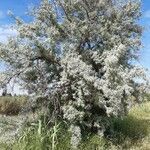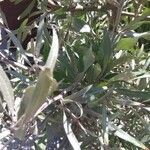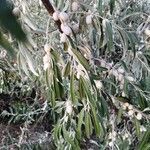Shrubs or small trees, 3-7(-10) m tall. Bark reddish brown; spines absent or sharp, 0.7-3 cm; young branches and both leaf surfaces silvery white, densely stellate-scaly, or adaxially grayish green or green and nearly without scales (var. virescens). Petiole 5-8 mm, 1/5-1/4 as long as blade; leaf blade oblong-lanceolate to linear-lanceolate, sometimes elliptic-lanceolate, ovate, or oblong-ovate, (2.5-)4-8(-10) × 0.4-3.2(-4) cm, adaxially dull green, or both surfaces silvery, with only white scales, base usually broadly cuneate, apex obtuse or subacute. Flowers 1-3 in axils of older leaves. Pedicel short, ca. 2 mm. Flowers fragrant, outside silvery white, with dense white scales and sparse small yellowish glands, inside yellow. Calyx tube campanulate or broadly campanulate (f. culta), ca. as long as limb, 5-6 × 2.5-3(-5) mm; lobes lanceolate, ovate, or triangular-lanceolate, slightly shorter than tube, inside yellow and glabrous, with sparse small brownish glands, distinctly 3-veined, apex ± acute. Filaments short; anthers oblong. Style base enclosed by tubular disk, curved in upper part, ca. as long as calyx. Drupe yellowish brown, globose-ovoid, globose, or subglobose (var. caspica), 0.7-2.5 × 0.5-1.3 cm, densely silvery scaly when young, subglabrous when mature; scales sparse, brownish; flesh sweet, mealy; stone oblong, oblong-ovoid, or narrowly cylindric (f. culta), both ends obtuse or pointed. Fl. May-Jun, fr. Aug-Oct. 2n = 28.
More
A large shrub or small tree. It loses its leaves during the year. It grows to 6-9 m high and spreads about 6 m across. The trunk is crooked. The bark is brown and shreds. The new branches and underside of the leaves are covered with silvery scales. The branches can have spines. The leaves are narrow. They are 4-8 cm long. The flowers are small and pale yellow inside but silvery outside. They have a scent. They occur in clusters of 1-3. The fruit are yellow and covered in silvery scales. They are about 2 cm long. They are edible.
Small, usually thorny tree to 10 m, the young twigs densely silvery; lvs lanceolate, 3–10 cm, silvery on both sides; fls as in no. 1 [Elaeagnus commutata Bernh.], except the style surrounded by a short, tubular disk just above the constriction of the hypanthium; fr 1 cm, yellow, with silvery scales; 2n=28. Native of Eurasia, planted for ornament and often escaped in c. and w. U.S., rarely eastward. June, July.
It grows in cold desert in north India. It is native to western Asia. It grows along coasts and near riverbanks and in dry riverbeds and floodplains. It does best with warm dry summers. It can tolerate salt soil. It will grow in almost any soils. It needs plenty of sunlight. It is frost hardy. In the Himalayas it grows between 1,800-3,500 m altitude. It can grow in arid places. It suits hardiness zones 2-9.
More
By streams and along river banks; at elevations up to 3,000 metres in Turkey. Sea coast, river and lake shores, dry river beds, also in mountains.













